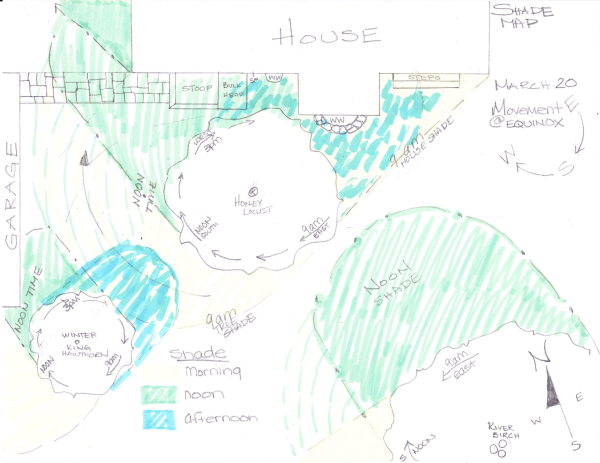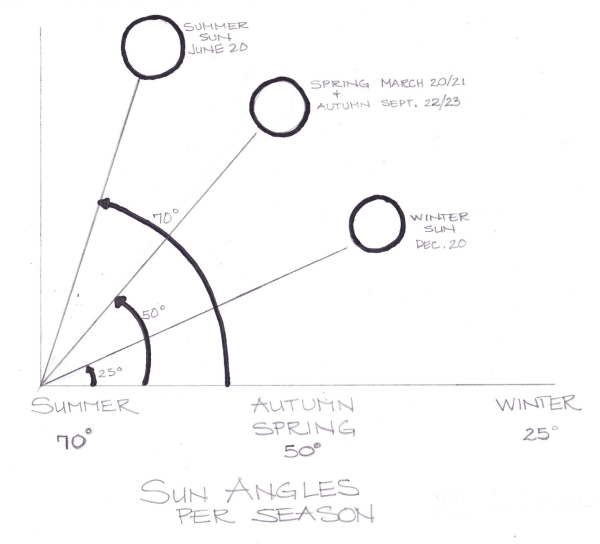To understand the available sun in your garden, map your shade.
Mapping the shade in your landscape is a very useful tool in landscape design. If you want to succeed in your garden endeavors, you are going to need to know where you have sun and where you don't.
Mistake Number ONE: Seeing sun and believing that space is sunny.
Just because you notice sun or shade on a parcel of land doesn't mean that this area will be hospitable to plants that prefer sun to shade or vice versa.
Why, you ask?
FACT TWO: The angle of the sun is changing with the seasons
In the northern hemisphere (New England in particular), the height of the sun (or solar altitude) is changing roughly 50 degrees in relation to the horizon over the year. So this means the sun is far higher in the sky in the summer (creating shorter shadows) than in the winter (longest shadows). Starting in the winter, the solar altitude increases through spring and peaks in summer. Then it begins to decrease through autumn to its lowest point in the winter sky.
Where you live on the globe matters! So if you are reading this and you are from Australia…don’t trust my information. Having never been to Australia or below the equator, I have no business giving information on the sun. It’s not wildly different…you have the same sun after all, but as to the reality of rise/set and angles, you might want to go to a better source. Click on this link to a well-written article on PhysicalGeography.com and read about Earth-Sun Geometry.
Incorporating the two above facts about the sun when you dive into garden planning will help you understand how the sun’s rays impact your garden. If you had no trees, no house, no garage or any other structure that could cast shade, this information would be enough.
The truth is most of us have some dwelling that will cast shade. Many of us have trees, too. If we don’t…then our neighbors certainly do.
 By creating a simple map of your shade, you will get a clearer picture of the true level of sun exposure in your garden. To do this right, you need to do it at least twice in the year – once in the summer and once in the spring or fall. If you really want to understand your exposure, map in all four seasons at the equinox and solstice.
By creating a simple map of your shade, you will get a clearer picture of the true level of sun exposure in your garden. To do this right, you need to do it at least twice in the year – once in the summer and once in the spring or fall. If you really want to understand your exposure, map in all four seasons at the equinox and solstice.
How to map your shade:
- Using graph paper, lay out the buildings and large trees on your property. Don’t worry about being totally exact, but be mindful with spacing and relative sizes.
- With your map in hand, visually watch and map the shade pattern by checking the yard at 9am, noon, and 3pm. This will give you three points to connect to make the arc of shade movement.
Remember these things when interpreting your map
- Shade moves clockwise (sun-wise) (north east interpretation).
- The more objects, the more shade – note the overlapping that occurs.
- The denser the object, the denser the shade – house shade is totally dense, trees with big leaves have denser shade than trees with small leaves.
- Evergreens cast shade year round.
- Deciduous plants (ones that lose their leaves) cast a denser shade when they are in full leaf and a light shade when they are leafless. Notice leaf size, too!

My map here shows morning sun in yellow, noon sun in green, and afternoon sun in blue. You can see that there is considerable overlap between tree shade and house shade. As much as I want a sunny back yard, this map proves I have a part shade to full shade environment. At best, I have a few small pockets of part sun. Now I know that eliminating lawn and moving toward more shade tolerant plant choices is the way to go.
Now with the shade in your yard mapped, you are ready to determine whether you have:
- Full sun – 6 plus hours
- Part sun – 4-5 hours of sun
- Part shade – 2-3 hours of sun
- Full shade – less than 1 hour of sun
Have fun with this exercise and enjoy the feeling of really knowing how much sun you have to offer your plants.

TWEETABLE TIP
Learn how to map the sun and shade in your garden
VIA @GardenContinuum

What discoveries have you made with your mapping? Let us know. Share your maps on Facebook!









Leave a comment